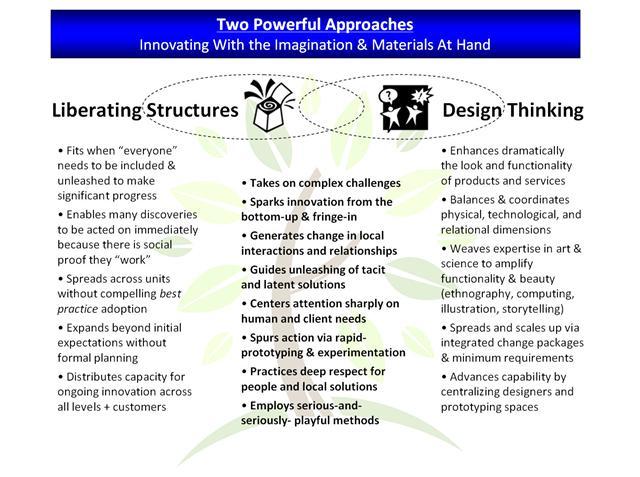Liberating Innovation
In your organization, does culture eat innovation strategy for lunch? Are innovations imported from afar... followed by elaborate buy-in strategies to overcome resistance? Liberating Structures invite everyone in your culture to eat lunch together. With ownership cultivated through inclusion, there is no resistance.
The central idea behind Liberating Structures is the power of including and unleashing everyone.
LS make it easy and inexpensive for you to advance your ideas and chase your dream.
We call it self-discovery within a group (it is one of ten LS Principles). LS amplify freedom to explore and responsibility to follow through from the ground-up and periphery-in.
Similarly, Amazon and Wikipedia make it simple to publish a book or an encyclopedia article. Everyone is encouraged and anyone can choose to do it. Their strategy is to eliminate barriers and gatekeepers. They distribute the power to publish to everyone. This creates a wondrously fertile soil for innovation.
 Growing out of the fertile soil are new solutions, fresh voices, novel prototypes, and new businesses. The speed and variety of innovation increases dramatically.
Growing out of the fertile soil are new solutions, fresh voices, novel prototypes, and new businesses. The speed and variety of innovation increases dramatically.
As you get started with LS, hold onto your hats. Routinely, disruptive innovation happens!
LS draw of the often unnoticed social origins of innovation. Even the most creative individuals and designers stand on the inventive shoulders of others. Great ideas exist in every corner and edge of the organization. Too often they go undiscovered or undeveloped. LS make it possible to tap local talent everyday, not just for special projects.
A quick review of the Field Stories reveals how often something-better-than-expected pops into being when LS are put into practice. Better yet, LS cultivate the soil for enduring cultural change. Embracing LS feels more like a movement than a project with a single goal.
Many LS are perfectly designed to spark innovation. The following LS are particularly powerful as you get started: 1-2-4-All, Improv Prototyping, Simple Ethnography, 25/10 Crowdsourcing, 15% Solutions, Shift-and-Share, and TRIZ.

Liberating Structures are often mixed-matched-and-mashed-up with other innovative change approaches. This includes but is not limited to Lean, Positive Deviance, and Design Thinking. LS seem to boost many efforts to generate momentum and innovation.
Below is one illustrated mash-up of Design Thinking and Liberating Structures. Partnering with the Innovation Learning Network has inspired creative collaborations.

Seven Attributes of Successful Innovators
The highly creative and adaptive behaviors of innovators are described below. These seven attributes represent the tacit or latent know-how of successful innovators.
1. Re-Invention Fidelity – Always and Never the Same: Innovators carefully manage fidelity (maintaining the always-the-same integrity of the core innovation), WHILE actively encouraging openness to local re-invention, never-the-same. If people learn best when they discover things for themselves, people adopt and sustain innovations best when they reinvent them to fit local conditions. (Always~Never)

2. Small Things Grow and Combine to Make Big Things: Innovators pay close attention to advancing very small, detailed or technical project elements or attributes – this may seem like a tendency toward aesthetics over practicality – WHILE staying attuned with “tangential” links to big regional or national movements. (Small~Big)
3. Simultaneous Mutual Shaping: Innovators are extremely deliberate in their project management actions, WHILE intensively noticing, reacting and being changed by what is actually unfolding. To and fro, they are shaping the world just as the world is shaping them. (Shaping~Shaped)
4. When Hard Work, Hope and History Rhyme: Innovators stick to a tight schedule for deliverables in the present, WHILE building toward an indefinite future tipping point. Innovators often believe they are playing one small part in something much bigger that is “trying” to happen. (Present~Future)
5. Structured-Yet-Improvisational Spread: Innovators make liberal use of formal communication channels – broadcasting the message to many people – while staying alert to unplanned, serendipitous connections to individuals and “happy accidents.” (Structured~Improvised)
6. Mountains Beyond Mountains Resilience: Innovators endure many reversals and disappointments, WHILE staying true to their purpose through wave-after-wave, mountain-beyond-mountain of challenge. At one time or another, each of the projects seemed fragile, under attack from the powers that be. Our innovators fought hard, picked themselves up after falls, and moved on to the next mountain or the next range. (Fragile~Resilient)
7. Social Proof Is the Pudding: Innovators rigorously generate quantitative evidence that their approach is an advance over common practice, WHILE amplifying social proof via word of mouth. Often, participation in prototyping or vetting generates social or qualitative proof that outstrips formal outcomes measurement. The innovation shines in its own light. (Quantitative~Qualitative)
Articles on mastering the art of innovating below:  Including everybody in seeing and shaping the future
Including everybody in seeing and shaping the future
Liberating Structures: Innovating by Including and Unleashing Everyone Lipmanowicz, McCandless
Mastering the Art of Innovating: A Funny, Wonderful Thing Happened on the Way to My Deliverable! DeWolf, McCandless
Oil, Water, Apples, Oranges: Bootstrapping Innovation with Social Networks Dewolf, McCandless
Transforming Discoveries: Partners on the Journey Keith McCandless, Linda DeWolf
Liberating Structures for Enduring Cultural Change: A Disruptive Innovation Keith McCandless, The Doctor Weighs In blog (a two part story)
